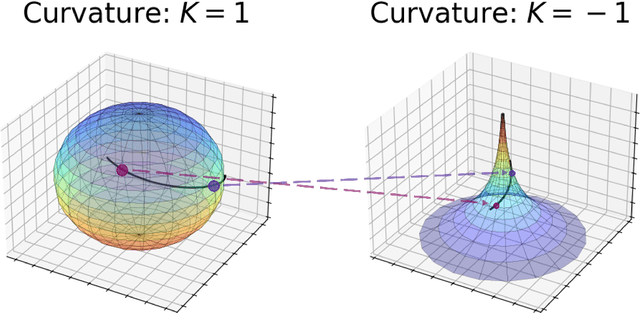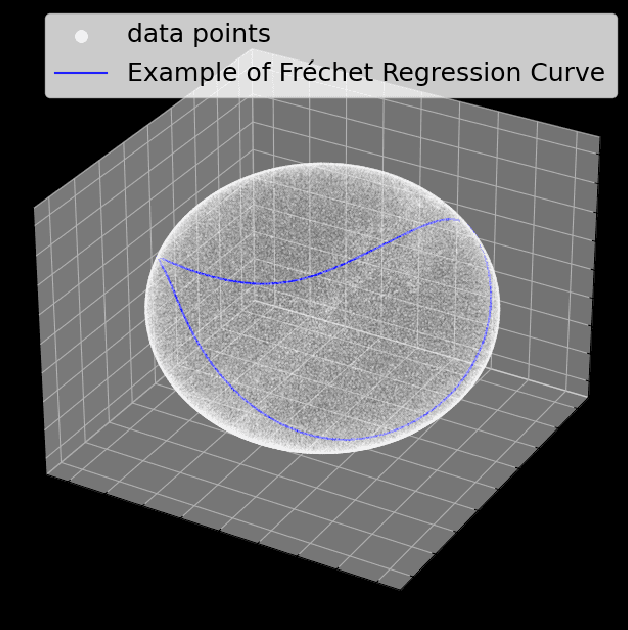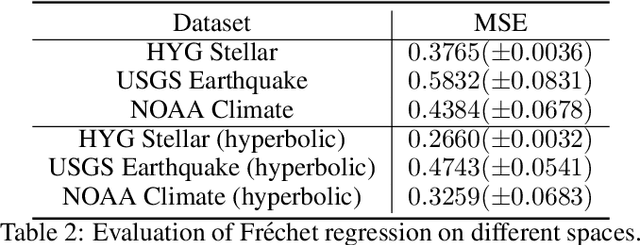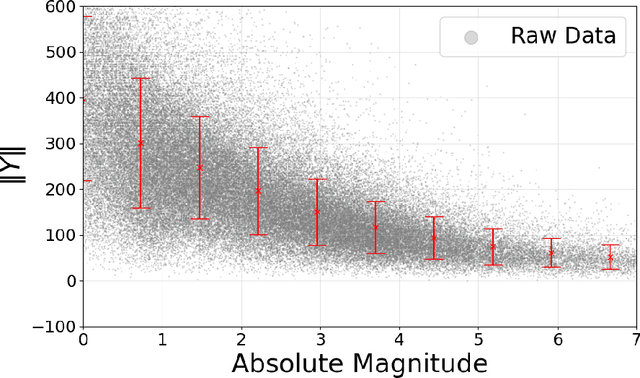Masanari Kimura
Generalized Power Priors for Improved Bayesian Inference with Historical Data
May 22, 2025Abstract:The power prior is a class of informative priors designed to incorporate historical data alongside current data in a Bayesian framework. It includes a power parameter that controls the influence of historical data, providing flexibility and adaptability. A key property of the power prior is that the resulting posterior minimizes a linear combination of KL divergences between two pseudo-posterior distributions: one ignoring historical data and the other fully incorporating it. We extend this framework by identifying the posterior distribution as the minimizer of a linear combination of Amari's $\alpha$-divergence, a generalization of KL divergence. We show that this generalization can lead to improved performance by allowing for the data to adapt to appropriate choices of the $\alpha$ parameter. Theoretical properties of this generalized power posterior are established, including behavior as a generalized geodesic on the Riemannian manifold of probability distributions, offering novel insights into its geometric interpretation.
Graph-Smoothed Bayesian Black-Box Shift Estimator and Its Information Geometry
May 22, 2025Abstract:Label shift adaptation aims to recover target class priors when the labelled source distribution $P$ and the unlabelled target distribution $Q$ share $P(X \mid Y) = Q(X \mid Y)$ but $P(Y) \neq Q(Y)$. Classical black-box shift estimators invert an empirical confusion matrix of a frozen classifier, producing a brittle point estimate that ignores sampling noise and similarity among classes. We present Graph-Smoothed Bayesian BBSE (GS-B$^3$SE), a fully probabilistic alternative that places Laplacian-Gaussian priors on both target log-priors and confusion-matrix columns, tying them together on a label-similarity graph. The resulting posterior is tractable with HMC or a fast block Newton-CG scheme. We prove identifiability, $N^{-1/2}$ contraction, variance bounds that shrink with the graph's algebraic connectivity, and robustness to Laplacian misspecification. We also reinterpret GS-B$^3$SE through information geometry, showing that it generalizes existing shift estimators.
Higher-Order Asymptotics of Test-Time Adaptation for Batch Normalization Statistics
May 22, 2025Abstract:This study develops a higher-order asymptotic framework for test-time adaptation (TTA) of Batch Normalization (BN) statistics under distribution shift by integrating classical Edgeworth expansion and saddlepoint approximation techniques with a novel one-step M-estimation perspective. By analyzing the statistical discrepancy between training and test distributions, we derive an Edgeworth expansion for the normalized difference in BN means and obtain an optimal weighting parameter that minimizes the mean-squared error of the adapted statistic. Reinterpreting BN TTA as a one-step M-estimator allows us to derive higher-order local asymptotic normality results, which incorporate skewness and other higher moments into the estimator's behavior. Moreover, we quantify the trade-offs among bias, variance, and skewness in the adaptation process and establish a corresponding generalization bound on the model risk. The refined saddlepoint approximations further deliver uniformly accurate density and tail probability estimates for the BN TTA statistic. These theoretical insights provide a comprehensive understanding of how higher-order corrections and robust one-step updating can enhance the reliability and performance of BN layers in adapting to changing data distributions.
Edgeworth Expansion for Semi-hard Triplet Loss
Mar 17, 2025Abstract:We develop a higher-order asymptotic analysis for the semi-hard triplet loss using the Edgeworth expansion. It is known that this loss function enforces that embeddings of similar samples are close while those of dissimilar samples are separated by a specified margin. By refining the classical central limit theorem, our approach quantifies the impact of the margin parameter and the skewness of the underlying data distribution on the loss behavior. In particular, we derive explicit Edgeworth expansions that reveal first-order corrections in terms of the third cumulant, thereby characterizing non-Gaussian effects present in the distribution of distance differences between anchor-positive and anchor-negative pairs. Our findings provide detailed insight into the sensitivity of the semi-hard triplet loss to its parameters and offer guidance for choosing the margin to ensure training stability.
Heteroscedastic Double Bayesian Elastic Net
Feb 04, 2025Abstract:In many practical applications, regression models are employed to uncover relationships between predictors and a response variable, yet the common assumption of constant error variance is frequently violated. This issue is further compounded in high-dimensional settings where the number of predictors exceeds the sample size, necessitating regularization for effective estimation and variable selection. To address this problem, we propose the Heteroscedastic Double Bayesian Elastic Net (HDBEN), a novel framework that jointly models the mean and log-variance using hierarchical Bayesian priors incorporating both $\ell_1$ and $\ell_2$ penalties. Our approach simultaneously induces sparsity and grouping in the regression coefficients and variance parameters, capturing complex variance structures in the data. Theoretical results demonstrate that proposed HDBEN achieves posterior concentration, variable selection consistency, and asymptotic normality under mild conditions which justifying its behavior. Simulation studies further illustrate that HDBEN outperforms existing methods, particularly in scenarios characterized by heteroscedasticity and high dimensionality.
Theoretical and Practical Analysis of Fréchet Regression via Comparison Geometry
Feb 04, 2025



Abstract:Fr\'echet regression extends classical regression methods to non-Euclidean metric spaces, enabling the analysis of data relationships on complex structures such as manifolds and graphs. This work establishes a rigorous theoretical analysis for Fr\'echet regression through the lens of comparison geometry which leads to important considerations for its use in practice. The analysis provides key results on the existence, uniqueness, and stability of the Fr\'echet mean, along with statistical guarantees for nonparametric regression, including exponential concentration bounds and convergence rates. Additionally, insights into angle stability reveal the interplay between curvature of the manifold and the behavior of the regression estimator in these non-Euclidean contexts. Empirical experiments validate the theoretical findings, demonstrating the effectiveness of proposed hyperbolic mappings, particularly for data with heteroscedasticity, and highlighting the practical usefulness of these results.
A Fashion Item Recommendation Model in Hyperbolic Space
Sep 04, 2024Abstract:In this work, we propose a fashion item recommendation model that incorporates hyperbolic geometry into user and item representations. Using hyperbolic space, our model aims to capture implicit hierarchies among items based on their visual data and users' purchase history. During training, we apply a multi-task learning framework that considers both hyperbolic and Euclidean distances in the loss function. Our experiments on three data sets show that our model performs better than previous models trained in Euclidean space only, confirming the effectiveness of our model. Our ablation studies show that multi-task learning plays a key role, and removing the Euclidean loss substantially deteriorates the model performance.
Density Ratio Estimation via Sampling along Generalized Geodesics on Statistical Manifolds
Jun 27, 2024



Abstract:The density ratio of two probability distributions is one of the fundamental tools in mathematical and computational statistics and machine learning, and it has a variety of known applications. Therefore, density ratio estimation from finite samples is a very important task, but it is known to be unstable when the distributions are distant from each other. One approach to address this problem is density ratio estimation using incremental mixtures of the two distributions. We geometrically reinterpret existing methods for density ratio estimation based on incremental mixtures. We show that these methods can be regarded as iterating on the Riemannian manifold along a particular curve between the two probability distributions. Making use of the geometry of the manifold, we propose to consider incremental density ratio estimation along generalized geodesics on this manifold. To achieve such a method requires Monte Carlo sampling along geodesics via transformations of the two distributions. We show how to implement an iterative algorithm to sample along these geodesics and show how changing the distances along the geodesic affect the variance and accuracy of the estimation of the density ratio. Our experiments demonstrate that the proposed approach outperforms the existing approaches using incremental mixtures that do not take the geometry of the
Explaining Black-box Model Predictions via Two-level Nested Feature Attributions with Consistency Property
May 23, 2024



Abstract:Techniques that explain the predictions of black-box machine learning models are crucial to make the models transparent, thereby increasing trust in AI systems. The input features to the models often have a nested structure that consists of high- and low-level features, and each high-level feature is decomposed into multiple low-level features. For such inputs, both high-level feature attributions (HiFAs) and low-level feature attributions (LoFAs) are important for better understanding the model's decision. In this paper, we propose a model-agnostic local explanation method that effectively exploits the nested structure of the input to estimate the two-level feature attributions simultaneously. A key idea of the proposed method is to introduce the consistency property that should exist between the HiFAs and LoFAs, thereby bridging the separate optimization problems for estimating them. Thanks to this consistency property, the proposed method can produce HiFAs and LoFAs that are both faithful to the black-box models and consistent with each other, using a smaller number of queries to the models. In experiments on image classification in multiple instance learning and text classification using language models, we demonstrate that the HiFAs and LoFAs estimated by the proposed method are accurate, faithful to the behaviors of the black-box models, and provide consistent explanations.
Geometric Insights into Focal Loss: Reducing Curvature for Enhanced Model Calibration
May 01, 2024



Abstract:The key factor in implementing machine learning algorithms in decision-making situations is not only the accuracy of the model but also its confidence level. The confidence level of a model in a classification problem is often given by the output vector of a softmax function for convenience. However, these values are known to deviate significantly from the actual expected model confidence. This problem is called model calibration and has been studied extensively. One of the simplest techniques to tackle this task is focal loss, a generalization of cross-entropy by introducing one positive parameter. Although many related studies exist because of the simplicity of the idea and its formalization, the theoretical analysis of its behavior is still insufficient. In this study, our objective is to understand the behavior of focal loss by reinterpreting this function geometrically. Our analysis suggests that focal loss reduces the curvature of the loss surface in training the model. This indicates that curvature may be one of the essential factors in achieving model calibration. We design numerical experiments to support this conjecture to reveal the behavior of focal loss and the relationship between calibration performance and curvature.
 Add to Chrome
Add to Chrome Add to Firefox
Add to Firefox Add to Edge
Add to Edge